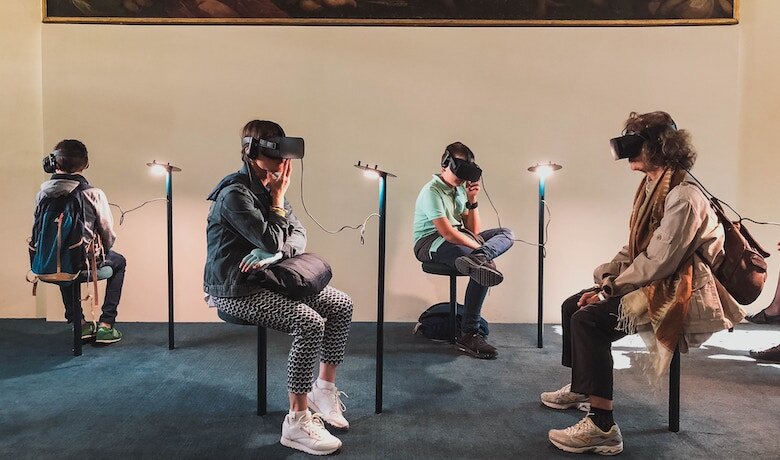Technology is becoming increasingly essential to the operations of museums and nonprofits. From making things more efficient behind the scenes to improving the customer experience, new and long-standing technologies are transforming the way organizations operate and delight visitors. Each year, we look forward to reviewing the predictions published by major research firms and leading technologists. Gartner, a leading global research and advisory firm, recently put out their latest predictions for trends that will accelerate technological progress in years to come.
As museums and nonprofits look to the latest technologies to help solve age-old challenges and excel in the modern age, it is essential that they stay on top of these predictions. Read on to explore what the top technology trends for 2020 could mean for the museum, arts, and culture sector.
1. Multi-Experience
According to Gartner, “Virtual reality (VR), augmented reality (AR) and mixed reality (MR) are changing the way in which people perceive the digital world. This combined shift in both perception and interaction models leads to the future multisensory and multimodal experience.” These technologies have untapped potentials within museums and cultural attractions, especially as the public's appetite for multisensory experiences continues to grow. The popularity of multi-experience is predicted to increase in 2020 and beyond.As we examined in depth back in 2018, Augmented Reality (AR) has the potential to transform the visitor experience in museums. An article in VentureBeat by Cuseum’s CEO examines the vast potential of augmented reality in the museum experience, and this merely scratches the surface.
2. Human Augmentation
Source: Mojo Vision
Human augmentation “explores how technology can be used to deliver cognitive and physical improvements as an integral part of the human experience.” This kind of augmentation has the potential to transform have visitors experience art and culture.
Earlier this month, we examined several cutting edge products released at the 2020 Consumer Electronics Show that have the potential to take museums to the next level. One of the big ones was AR-contact lenses by Mojo Vision, which will allow “14K pixels-per-inch microdisplays, wireless radios, image sensors, and motion sensors” to fit comfortably in the eyes.
Today, AR experiences rely on a handheld mobile device, but in the future, human augmentation will become widespread and highly applicable to the museum experience.
3. Transparency and Traceability
In the world of big data, advancements in artificial intelligence, and widespread surveillance technology, “Consumers are increasingly aware that their personal information is valuable and are demanding control.” With the growing role data plays today, it will become vital for museums to step up their game in the areas of cybersecurity and overall transparency about how they collect and use the data of their visitors and constituents.
As museums and nonprofits increasingly employ big data, cloud technology, CRMs, marketing automation, 5G, artificial intelligence, predictive analytics, and more, they will need to make even bigger strides towards securing and the managing personal data of their visitors, members, donors, and patrons.
4. Autonomous Things
Source: Smithsonian
According to Gartner, “Autonomous things are physical devices that use AI to automate functions previously performed by humans.” Museums such as The Smithsonian and Musée du quai Branly are already employing robot tour guides, robot docents, and ”deepfake” versions of famous artists to engage their visitors, it is likely that as autonomous things proliferate in 2020, we will start to see even more examples and use cases within museums and cultural attractions.
5. Practical Blockchain
Blockchain is a digital, distributed, decentralized ledger which has become a hot topic over the past few years. It was first used as the foundation of cryptocurrencies such as Bitcoin, but blockchain’s ability to track and validate has several emerging applications in the nonprofit . Blockchain’s foremost application is as a chronological, digital framework for tracking the movement of physical and digital objects.
A number of forward thinking startups working on the intersection of art and technology have already begun utilizing blockchain in creative ways. For example, Verisart is “a blockchain platform that helps users create secure digital certificates for art and collectibles.” Artory is another startup which “tracks provenance for art and other collectibles using a blockchain ledger to make sure that custody chains are authentic and tamper-proof.” And those are just a few examples of a slew of startup.
There is also the hope that blockchain might finally be able to bring transparency to the art market. As we move into 2020, we can anticipate even more use cases for blockchain in arts and culture!
6. AI Security
We’ve been thinking about artificial intelligence in museums for years now, but 2020 is presenting new challenges for security and discretion around the use of this technology. According to Gartner, the use of AI opens more “potential points of attack with IoT, cloud computing, microservices and highly connected systems in smart spaces.”
In the past few years, there have been several cases of cybersecurity incidents where museums and nonprofits were targeted. This past May, hackers launched a Ransomware cyber-attack that disabled much of San Francisco’s Asian Art Museum's computer systems. Back in 2017, a data breach from an email phishing scam at the Denver Art Museum compromised the personal information of hundreds of customers, donors and employees at the museum.
The good news is that sophisticated AI also makes it easier to anticipate and protect against cyber attacks. As artificial intelligence technology becomes increasingly widespread, it will become affordable and user-friendly for all kinds of museums and organizations, even those with tight budgets and limited tech savvy. Gartner has predicted that 2020 will witness the rise of “leveraging AI to enhance security defense.”
7. The Empowered Edge
Source: Beijing Palace Museum
You’ve perhaps heard the term “edge computing” thrown around lately, but just what does it mean? According to Gartner, this is a technology, closely affiliated with the Internet of Things (IoT), through which “information processing and content collection and delivery are placed closer to the sources, repositories and consumers of this information.”
Edge computing and the proliferation of 5G technology will be essential in introducing cutting edge IoT experience into the museum space. Installing IoT infrastructure within museums could involve networked sensors, “smart” lighting and frames, fully contextual digital signage, and new types of experiences layered on top of the new network.
In recent years, museums and nonprofits have increasingly adopted technology to assist in a variety of functions, as well as embraced digitally-savvy leadership that can help successfully guide them. From improving wayfinding, providing immersive experiences, streamlining operations, offering digital conveniences, and curating the visitor journey, technology has diverse applications in the museum ecosystem. While nonprofits are not always the first to adopt emergent technologies, it is imperative that industry leaders stay up to date on the latest trends and technology.
Interested in leveraging cutting-edge technology at your museum or nonprofit? Download our free guide: How to Launch & Succeed with Digital Membership Cards
Further Reading:
The Benefits of Having a Digitally Savvy Board – for Museums & Nonprofits Too
5 New Technologies Unveiled at CES that Could Shape the Future of the Museum Experience
3 Reasons Why Museums and Nonprofits Should be Thinking About Cybersecurity
4 Technologies Opening New Doors for Provenance Research and Education








